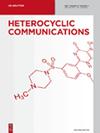SbCl3催化喹唑啉-4(3H)-的微波辅助合成
IF 1.5
3区 化学
Q3 CHEMISTRY, ORGANIC
引用次数: 8
摘要
摘要三氯化锑(SbCl3)是一种有效的催化剂(1mol%),可用于邻氨基苯酰胺与各种醛或酮在微波辐射下缩合成喹唑啉-4(3H)-酮衍生物,产率良好。该过程在无溶剂条件下在几分钟内进行。这种通用方法具有简单、反应条件温和和产物产率高的优点。本文章由计算机程序翻译,如有差异,请以英文原文为准。
Microwave-assisted synthesis of quinazolin-4(3H)-ones catalyzed by SbCl3
Abstract Antimony(III) trichloride (SbCl3) is an effective catalyst (1 mol%) for the condensation of anthranilic amide with various aldehydes or ketones to quinazolin-4(3H)-one derivatives in good to excellent yields under microwave irradiation. The process is carried out within several minutes under solvent-free conditions. This general methodology has the advantages of simplicity, mild reaction conditions and high yields of products.
求助全文
通过发布文献求助,成功后即可免费获取论文全文。
去求助
来源期刊

Heterocyclic Communications
化学-有机化学
CiteScore
3.80
自引率
4.30%
发文量
13
审稿时长
1.4 months
期刊介绍:
Heterocyclic Communications (HC) is a bimonthly, peer-reviewed journal publishing preliminary communications, research articles, and reviews on significant developments in all phases of heterocyclic chemistry, including general synthesis, natural products, computational analysis, considerable biological activity and inorganic ring systems. Clear presentation of experimental and computational data is strongly emphasized. Heterocyclic chemistry is a rapidly growing field. By some estimates original research papers in heterocyclic chemistry have increased to more than 60% of the current organic chemistry literature published. This explosive growth is even greater when considering heterocyclic research published in materials science, physical, biophysical, analytical, bioorganic, pharmaceutical, medicinal and natural products journals. There is a need, therefore, for a journal dedicated explicitly to heterocyclic chemistry and the properties of heterocyclic compounds.
 求助内容:
求助内容: 应助结果提醒方式:
应助结果提醒方式:


